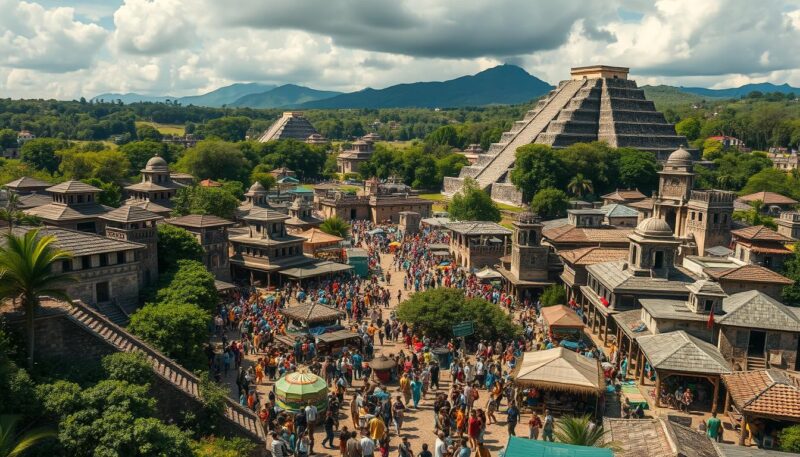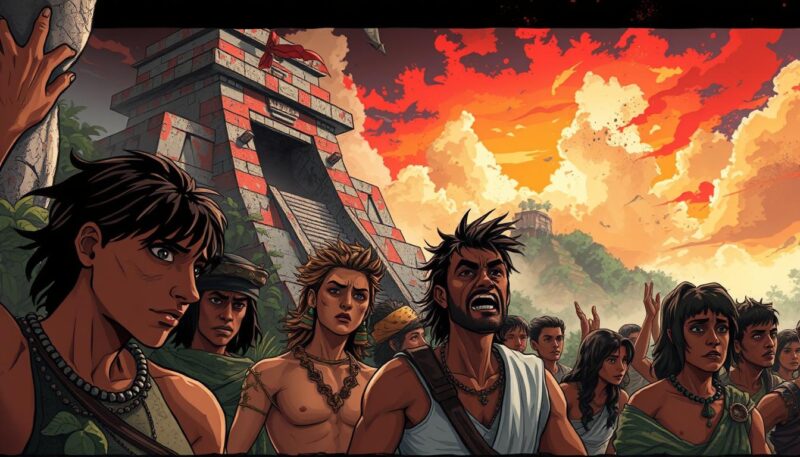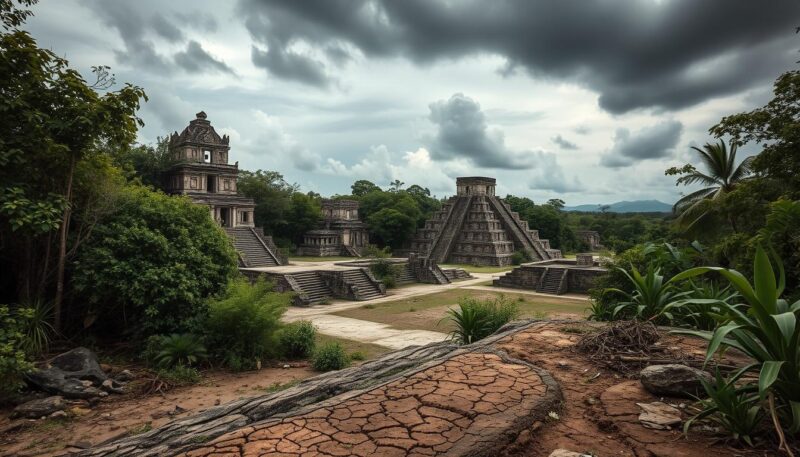The grandeur and complexity of the ancient Maya civilization have captivated researchers and travelers alike for centuries. How Did the Mayans Fall into decline from such a thriving apex? Between the Classic Period, which spanned from A.D. 250 to 900, and the gradual abandonment of key urban centers, this fascinating story unfolds against a backdrop of environmental, social, and political factors. While significant cities such as Tikal underwent this dramatic transformation, it is essential to note that the Maya people did not entirely vanish; some regions in the northern Yucatán found ways to adapt and endure even in the face of postclassic Maya history’s challenges.
Through a deep dive into historical theories, we observe that significant events like drought and deforestation linked to ancient climate change played a crucial role. Multiple droughts, particularly those occurring between 850 and 1000 A.D., along with a growing population and shifting agricultural practices, contributed to a landscape stricken by decline. Scholars have long debated these narratives, suggesting that while not all Maya urban areas perished, many did, leading to unsettling changes in their way of life. Join us as we explore the intricate dynamics of the Maya’s fall, shedding light on this iconic civilization’s legacy.
The Rise of the Maya Civilization
The ascent of the Maya civilization stands as one of the most notable examples of urban development in pre-Columbian America. Emerging around 2000 B.C., this ancient Maya culture transitioned from modest hunter-gatherer societies into complex civilizations featuring sophisticated social structures, agricultural practices, and monumental architecture. The historical overview of the Maya illustrates their ingenuity and adaptability in various regions, encompassing the Yucatan Peninsula, Guatemala, Belize, and parts of modern-day Honduras and El Salvador.
Historical Overview of the Maya
The history of the Maya civilization is marked by remarkable advancements, particularly during the Preclassic and Classic periods. The Preclassic era, lasting from 2000 B.C. to A.D. 250, saw the establishment of significant communities like Mirador, reflecting early development in urban centers. The Classic period (A.D. 250 to 900) witnessed the maturation of Maya cities, with around 40 principal urban centers emerging, each with populations ranging from 5,000 to an impressive 50,000 inhabitants. These vibrant Maya cities became hubs of cultural, political, and religious activity, embodying the brilliance of ancient Maya culture.
Peak Population and Urban Centers
The peak population of the Maya, estimated to be between 2 and 10 million, showcases the civilization’s remarkable demographic expansion. This period was characterized by an intricate social hierarchy and the flourishing of urban centers such as Tikal, Calakmul, and Palenque. Each city featured grand ceremonial architecture, expansive plazas, and richly adorned temples, evidencing the artistic and architectural legacy of the Maya civilization. The Late Classic period particularly highlighted the thriving Maya cities, where communal gatherings and rituals underscored the cultural richness and complexity of daily life.
| Urban Center | Estimated Population | Period of Prominence |
|---|---|---|
| Tikal | 50,000 | Classic Period |
| Calakmul | Unknown (major rival of Tikal) | Classic Period |
| Palenque | Up to 25,000 | Classic Period |
| Copan | Approx. 10,000 | Classic Period |
| Chichen Itza | Estimated 35,000 | Post-Classic Period |
Factors Leading to the Collapse
The collapse of the Maya civilization resulted from a complex interplay of factors, including overpopulation, environmental degradation, and climate change. Each of these aspects played a crucial role in creating a perfect storm that destabilized this once-prosperous civilization.
Overpopulation and Resource Strain
Overpopulation among the Mayans significantly contributed to the challenges they faced. By the late Classic period, cities like Tikal had populations reaching around 50,000 inhabitants, while many smaller towns housed approximately 5,000. This rapid growth led to a substantial resource strain as agricultural lands struggled to meet the needs of an ever-expanding population. This imbalance sparked tensions, highlighting that the relationship between food demand and ecological balance is crucial. The increasing population put immense pressure on local resources, contributing to the eventual Mayan civilization decline.
Environmental Degradation and Deforestation
Environmental degradation was a direct consequence of the Maya’s agricultural practices. Deforestation and the Maya civilization are tied to the extensive land-clearing required for crop cultivation and urban expansion. Significant deforestation resulted in soil erosion, reducing agricultural fertility and making it increasingly difficult to sustain large populations. The ongoing exploitation of natural resources compounded the decline, leading to habitat loss and diminishing biodiversity. The depletion of these critical resources illustrated how human activities can negatively impact the environment, highlighting the interdependent nature of societies and their surroundings.
Climate Change and Drought Theories
Climate change profoundly impacted the ancient Maya, particularly through recurring droughts. Studies suggest that the Maya lowlands experienced several prolonged drought events around the 9th century. The Mayan drought theories posit that these climatic shifts resulted in severe water shortages, leading to crop failures and triggering localized famines. This agricultural distress severely disrupted society, driving populations towards more fertile lands or inciting other forms of unrest. Researchers have explored the possibility of a megadrought, positing that this ancient climate change was a significant factor underlying the collapse of the Maya civilization.

How Did the Mayans Fall?
The fall of the Maya civilization represents a complex tapestry of internal strife and external pressures. This period of turmoil set the stage for dramatic transformations in the socio-political landscape of the region. Understanding the internal conflict Maya faced is crucial to grasping the full picture of societal collapse Maya experienced during this tumultuous time.
Internal Conflict and Societal Collapse
Throughout the 7th and 9th centuries CE, internal conflict among the various Maya city-states intensified. As competition for dwindling resources surged, warfare became a frequent occurrence. Archaeological findings document significant attacks on cities that had experienced a rapid decline in population. For instance, the population in the Copán Valley fell drastically from about 28,000 in the early centuries to roughly 15,000 by 900 CE, with numbers dwindling to under 1,000 by 1200 CE. The escalation of violence and political instability marked a historic shift leading to Mayan city abandonment.
With ruler authority diminishing, many inhabitants fled urban centers or reverted to smaller, less complex settlements. This decline in societal structure exemplifies the profound impact of the internal conflict on the overall stability of the Mayan civilization, ultimately facilitating its downfall. Historical accounts indicate previous societal disruptions had not typically culminated in mass abandonment, marking this collapse as a unique event. Changing climate conditions exacerbated the strain, as agricultural failure contributed to the exhaustion of community resources.
Impact of the Spanish Conquest
In the early 1500s, the Spanish conquest of the Maya compounded the chaotic landscape left by internal strife. These conquest efforts exploited existing divisions within the fragmented Maya groups, resulting in further violence and societal disruption. The last independent Mayan city, Nojpeten, succumbed to colonial rule in 1697, completing a tragic chapter in a civilization known for its architectural and cultural achievements. The rich histories and traditions established by the Maya were often left in ruins amidst the sweeping changes introduced by Spanish colonizers.

Conclusion
The fall of the Maya civilization serves as a complex case study that underscores the intricate relationship between population dynamics, environmental sustainability, and societal resilience. As we conclude our exploration of the events leading to the decline of this once-thriving civilization, we observe that over the course of nearly 2,000 years, the Maya faced challenges including severe droughts, resource depletion, and societal strife. This paints a vivid picture of how civilizations can be impacted by environmental changes, revealing critical lessons for contemporary societies. The conclusion on the Mayan fall is not merely an endpoint but a source of understanding essential for today’s global community.
Moreover, the history of the Maya reminds us that the echoes of their legacy still resonate through their descendants, many of whom continue to inhabit the lands once filled with vibrant city-states like Tikal. In studying the lessons from the Mayan collapse, modern societies can glean insights into the importance of sustainable practices that support ecological balance. The evidence suggests that the repeat occurrences of droughts, some lasting several years, played a pivotal role in the catastrophic decline, challenging the sustainability of their agricultural practices.
In essence, as we reflect on the factors contributing to the collapse of the Maya civilization, the call for sustainable development has never been more urgent. By applying the lessons from the Mayan collapse to current practices, there is potential not only to prevent similar declines in other societies but also to foster a more harmonious relationship with our environment. The rich history of the Maya serves as a reminder that in seeking progress, one must honor the delicate balance of nature.

